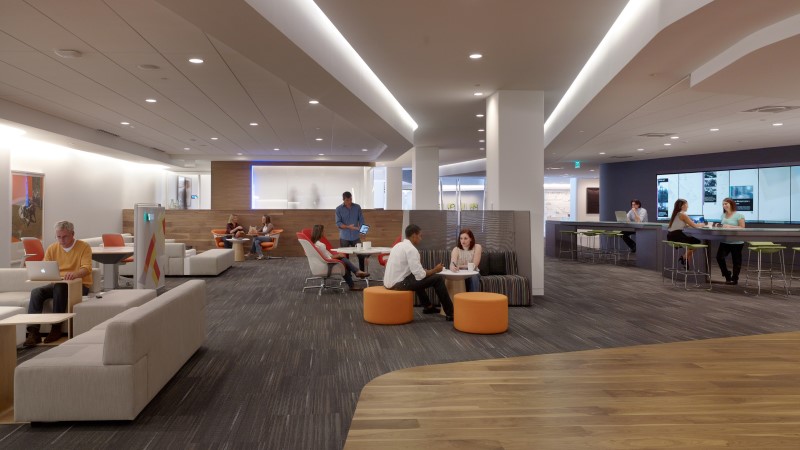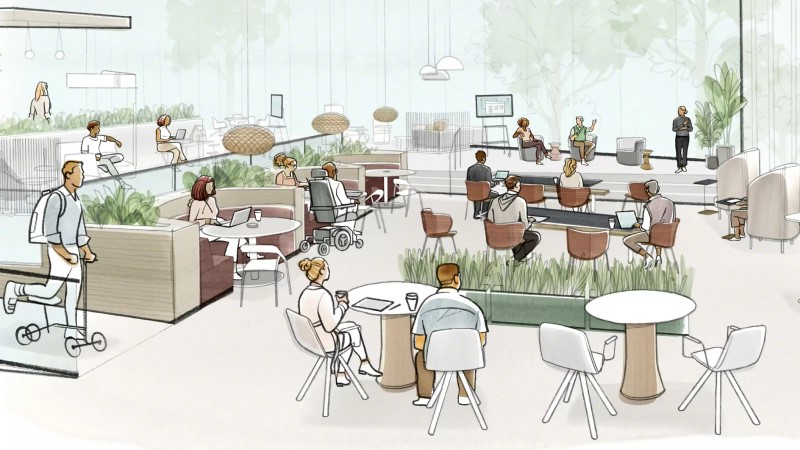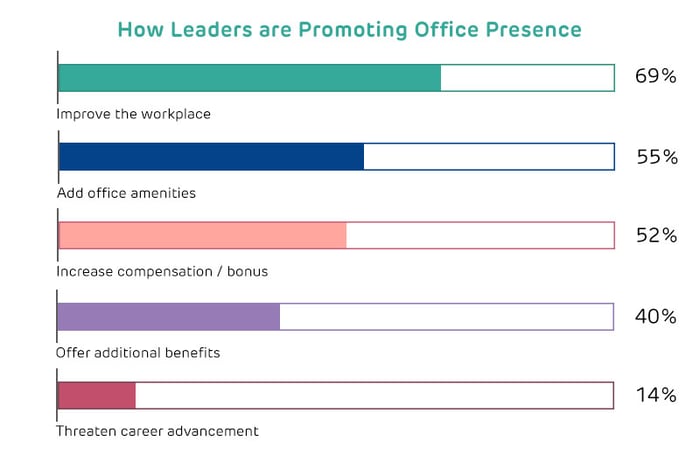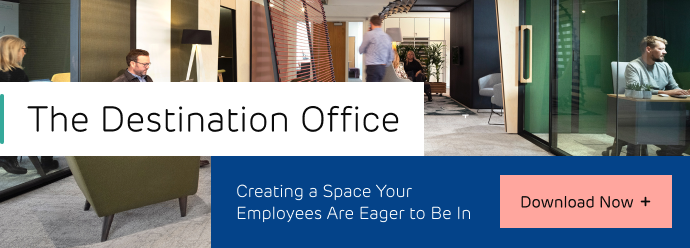For employees and managers who have settled into the rhythms of hybrid working, the latest KPMG research on leaders’ future plans may come as something of a shock.
For many the WFH revolution may be over
“Despite the widespread adoption of hybrid work patterns by most office-based employers since the pandemic, the KPMG survey found 64% of leaders globally, and 63% of those in the UK, predicted a full return to in-office working by 2026.”
KPMG CEO Outlook Survey
We have, of course, already seen something of a backlash against the hybrid movement from some notable leaders. While the likes of DropBox may have gone virtual first, some companies such as Goldman Sachs have been much more militant in ordering their employees back to the office.
What’s the best way to encourage return to the office?
Some leaders are simply ordering staff back, imposing sanctions and penalties for those who don’t comply. In the long term this may back-fire as leaders look out of touch and insensitive to the needs and preferences of workers who have found new freedom and power in flexible working practices.
But removing these freedoms unilaterally is likely to backfire.
Just look at the reaction to the town-hall video posted recently by the US company WebMD for their workers. Their CEO bluntly declared the era of WFH was over with the words:
“We aren’t asking or negotiating at this point. We’re informing.”
The video then showed workers rejoicing at the prospect of a return to the office. It was a sight to which one anonymous employee responded:
“I've seen better acting by hostages in direct to DVD movies.”
Compromise and incentive is the way forward
Other leaders are realising their desire to bring more employees back into the office more of the time is only likely to work if it’s focused on improving their workplace experience and enhancing their EVP (employee value proposition).
Gartner release new research on the ‘best way back’
The latest study by Gartner (precised by researchers in the HBR) looked at organisations who have been successful in encouraging large scale, return to the office.
They found compromise, collaboration and a focus on renewed workplace benefits, rather than issuing ultimatums, was the way to bring more people back into the office without triggering resentment and resignations.
Three key ways to help workers ‘choose to return’
Gartner’s research makes three important recommendations to leaders to make their strategy a success.
The number one finding reiterated by Gartner is to resist the temptation to make the return to the office mandatory.
Instead, encouragement and negotiation is the most effective strategy to see a creative and productive return to the office.
1. Ensure employee autonomy
“Organizations need to shape their return-to-office approach to help employees feel that they still have a sense of control and agency over their behaviors and decisions.”
Gartner suggests some ways key ways to keep employees invested and engaged in your process.
Provide guidance rather than instructions
Develop policies that provide guidelines rather than strict requirements, allowing a balance of structure and freedom for your workers.
Co-create new working timetables with employees
Empower managers and teams to co-create flexible working patterns that work for them.
Offer meaningful and tangible benefits
Provide meaningful benefits like commuting subsidies, on-site childcare, and food options. For example, many organisations are building cafeterias as ‘third spaces’ where employers can come to ‘lunch, learn and connect’’ beyond the traditional office setting.

Such spaces have proved to be a powerful magnet for hybrid workers tired of sitting in local coffee shops, but who don’t want to completely sacrifice the independence of their hybrid working lives But a successful design of these third spaces is vital if they’re going to be effective.
“Creating an effective corporate third place involves more than access to good coffee and Wi-Fi—it’s about integrating work and life. It’s about creating an environment that supports the wellbeing of people physically, cognitively and emotionally.”
Cherie Johnson
Director, Global Design, Steelcase
A carefully designed third space combines provision for private working, as well as settings for socialising and more formal meetings.
- Spaces divided with plants and screens to control acoustics/sightlines
- Tables and seating with adequate access to power and wifi
- A mix of seating for thoughtful and more intentful work/different work postures
- Settings that encourage and support casual encounters with colleagues
- Light, airy settings with biophilic elements to encourage relaxation and creativity
2. Facilitate meaningful connection
Gartner says employers must be highly intentional in their ‘return to the workplace strategy’. Otherwise, they risk their workers becoming disillusioned and disengaged by the experiences they have when they get there.
Employer’s objectives must be to use office time to:
Build the connections that can lead to both personal and professional growth: mentoring, sponsorships, opportunities for ‘stretch experiences’, and high-visibility projects”
To do this they must:
-
Address the challenge of hybrid employees feeling isolated when they do come to the office. Don’t insist on your people coming in, even when no one else is!
-
Allow teams to plan their days working in the office collectively, rather than mandating a specific number of days that must be worked on-site every week.
-
Organise regular offsites to foster meaningful social connections and informal networking.
If teams are going to profit from days in the office, they must be together for a reason - to focus on delivering a specific project, to learn together or to bond more successfully.
Our workplaces must be set up as hubs for successful collaboration and learning. To do this they must be agile and responsive to the different stages of the collaborative process, from concentrated solo and small group work - to larger-scale learning.

And it’s worth remembering the office may not be the best place to achieve every one of your goals.
3. Foster inclusion
It’s easy to forget that for many people remote working has increased their sense of empowerment. For a lot of employees the digital workplace has been the ‘great leveller’:
“Remote workers actually experience 10% higher inclusion than onsite workers, partially because they are able to feel more authentic. Sixty-two percent of employees reported they feel they can be themselves best in a remote environment, where they have privacy and control over their workspace.”
Gartner’s research calls on employers to:
-
Understand how employees experience inclusion in the office versus remotely.
-
Equip teams to foster an inclusive culture, setting clear norms and operating principles.
-
Embed inclusion into everyday work, encouraging self-reflection and understanding of peers’ needs.
Building office spaces that acknowledge and accommodate neuro-diversity and other kinds of difference, is essential to create welcoming and productive workplaces going forward.
Employees should consider how their spaces can be designed to allow those with different needs to:
-
Find privacy and respite from crowded, busy areas.
-
Control light, temperature, ventilation and noise levels more successfully.
-
Navigate in potentially large, featureless office spaces.
“Breaking away from the prevailing mindset of office uniformity and conformity is key. Organizations must offer an employee-centred workspace where workers feel as comfortable and connected in the office, as they do at home. This requires understanding and empathizing with employees’ unique situations and asking what’s working, what’s not, and what can be done differently.”
Gartner
What can you offer your workers to ease their return? Wellness rooms? Provision for menopause support? Designs and layouts sensitive to neurodivergence?
Work with your team to make the space as versatile and well-appointed as possible - a place where inclusive design is practised as standard - not as an afterthought.

Return to the office? It can’t all be on your company’s terms
If your business is seeking a more complete return to the office, you’re going to need to compromise. The pandemic has fundamentally altered the landscape of work, shifting employee expectations and introducing new norms in workplace flexibility. But this flexibility can cut both ways, with employees willing to work longer hours in return for greater freedom of choice around work patterns.
The Gartner research underlines the role the physical workplace can play in encouraging your workers to embrace more opportunities for face-to-face.
Improvements to the workplace experience should be a priority
The conclusions of their study echoes the recent findings of Steelcase researchers who quizzed business leaders on how they were planning to increase workers’ attendance in their buildings.
Their research found most were looking to make the office and its amenities a centrepiece of their efforts to boost attendance - looking to build places where people ‘want to come’ rather than where they ‘have to come’.

The workplace as incentive
The shared physical workspace, therefore, has the potential to be the USP for workers once again.
After all, it’s here where we have the opportunity to meet and socialise, to receive training and mentorship - to experience the bonding and inspiration that may be missing in a WFH set up. Not only this, but tangible, practical benefits can be a big draw, too.
As many businesses have found, offering subsidised or even free food options on-site can be a big incentive to come back in - and with WFH fuelling a back pain crisis - the opportunity for focused work in ergonomic surroundings can also be an enticement.
But return to the office strategies have to be more than playing off carrot and stick.
Gartners' takeaways about return to the office
Gartner stresses the importance of collective agreement and compromise when it comes to ‘returning to the office’.
Workers must have agency and a voice in the process - and be consulted about what changes in the workplace they want to see.
When this happens:
-
Return-to-office mandates should be strategic and transparent to avoid feeling like a reversal of employee autonomy and well-being.
-
Leaders should navigate the return-to-office revolution in a way that strengthens employees’ connection to the organisation and its purpose.
-
Maintain an open dialogue with employees, keeping the organization's purpose as the guiding principle.
-
Adapt to changing circumstances in a way that benefits both the business and its stakeholders.












